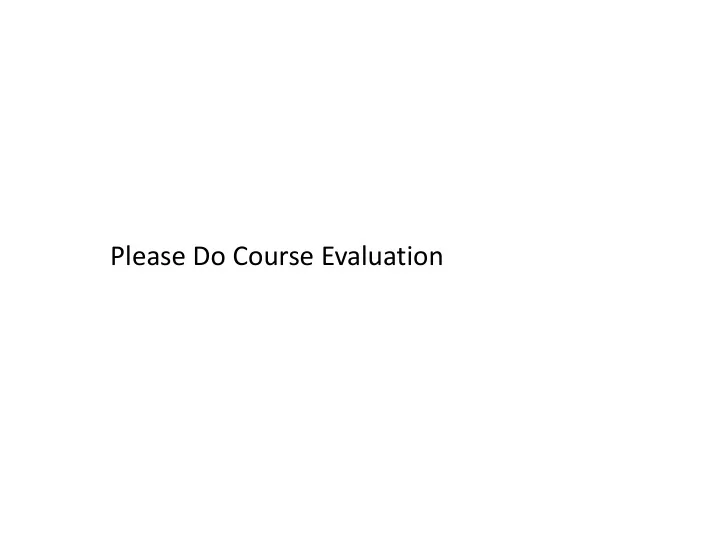

Please Do Course Evaluation
RLC circuit RLC circuit Solution: R - t 2L Q(t) Q e cos 0 d 2 1 R d LC 2L 0 under damped 2 1 R 0 critically damped LC 2L 0 over damped Kirchhoff' s rule : Q dI d 0 IR L (I Q ) C d t dt 2 d d Q L Q R Q 0 2 dt C dt
Damping R - t d real: under damped 2L Q(t) Q e cos 0 d d = 0: critically damped d imaginary: overdamped 2 1 R d LC 2L
Class 43 Displacement currrent
Maxwell’s Equations Maxwell’s equations describe all the properties of electric and magnetic fields and there are four equations in it: Integral form Differential form Name of equation (optional) 1 st Equation Electric E d A Q E Gauss’s Law 0 enclosed 0 Magnetic B B d A 0 Gauss’s Law 0 Ampere’s B d I B J Law 0 enclosed 0 (Incomplete) B E d - B (t) d A E - t t B Lorentz force equation is not part of Maxwell’s equations. It describes what happens when charges are put in an electric or magnetic fields: F (q E v B ) Slide #6 of Class 36
Revisit Ampere’s Law For DC, I=0 and B=0, so there is no problem. If I is changing with time, I 0 (except at the gap) and there will be a magnetic field (changing with time also). d If the gap d is very small (d 0), there should be magnetic field everywhere surrounding the wire even though there is no physical current through the gap. The problem now is: For surface S : B d s I I 1 0 Enclosed 0 by S Path P 1 For surface S : B d s I 0 2 0 Enclosed by S Path P 2 How to reconcile the difference?
Maxwell’s proposal We can introduce an imaginary current, called displacement current, I d within the I gap so the current now looks like continuous. With this displacement current: S 2 d I d For For surface surface S S : : B B d d S S I I I I 1 1 0 0 Enclosed Enclosed 0 0 by by S S P P 1 1 P For For surface surface S S : : B B d d S S I I I I I I S 1 2 2 0 0 Enclosed Enclosed 0 0 d d 0 0 I by by S S P P 2 2 Ampere’s Law now becomes: 1 B d S (I I ) 0 Enclosed d
Displacement current But at the end what is a displacement current? I It is not a real current due to motion of charges within the gap, so we have to relate it to something that really exists in the gap: electric field. S 2 dq dV d I d I I C (q CV) d dt dt dE Cd (V Ed) dt P S 1 A dE A I 0 0 d (C ) d dt d d(EA) 0 dt d E 0 dt
Abstraction d E I d 0 dt I We got this idea from parallel plate capacitor. We expand this and say this is generally true for any S 2 geometry and Ampere’s Law now becomes: d I d d E B d S (I ) 0 Enclosed 0 dt P S 1 I d (I E d A ) 0 Enclosed 0 dt
Maxwell’s Equations Maxwell’s equations describe all the properties of electric and magnetic fields and there are four equations in it: Integral form Differential form Name of equation (optional) 1 st Equation Electric E d A Q E Gauss’s Law 0 enclosed 0 Magnetic B B d A 0 Gauss’s Law 0 Ampere’s B d I B J Law 0 enclosed 0 (Incomplete) B E d - B (t) d A E - t t B Lorentz force equation is not part of Maxwell’s equations. It describes what happens when charges are put in an electric or magnetic fields: F (q E v B ) Slide #6 of Class 36
Maxwell’s Equations Maxwell’s equations describe all the properties of electric and magnetic fields and there are four equations in it: Integral form Differential form Name of equation (optional) 1 st Equation Electric E d A Q E Gauss’s Law 0 enclosed 0 Magnetic B B d A 0 Gauss’s Law 0 Ampere’s Law B ( J E ) B d (I E d A ) 0 enclosed 0 0 0 t t (Incomplete) B E d - B (t) d A E - t t B Lorentz force equation is not part of Maxwell’s equations. It describes what happens when charges are put in an electric or magnetic fields: Slide #6 of Class 36 F (q E v B )
Three different forms of Maxwell’s Equations
Linearly polarized electromagnetic Waves The wave is traveling in the E B direction. Linearly polarized waves
Applying Maxwell’s Third Equation to Plane Electromagnetic Waves d E d s - B d A d t E d s E(x dx) 0 - E(x) 0 [E(x dx) - E(x)] E dx x d - B d A - ( B dx) d t t B - dx t E B - x t
Applying Maxwell’s Fourth Equation to Plane Electromagnetic Waves d B d s (I E d A ) (I 0 ) 0 in 0 in dt B d s B(x) 0 - B(x dx) 0 - [B(x dx) - B(x)] B - dx x d E d A ( E dx) 0 0 0 0 d t t E dx 0 0 t B E - 0 0 x t
Recommend
More recommend